Smart Meters Market Size
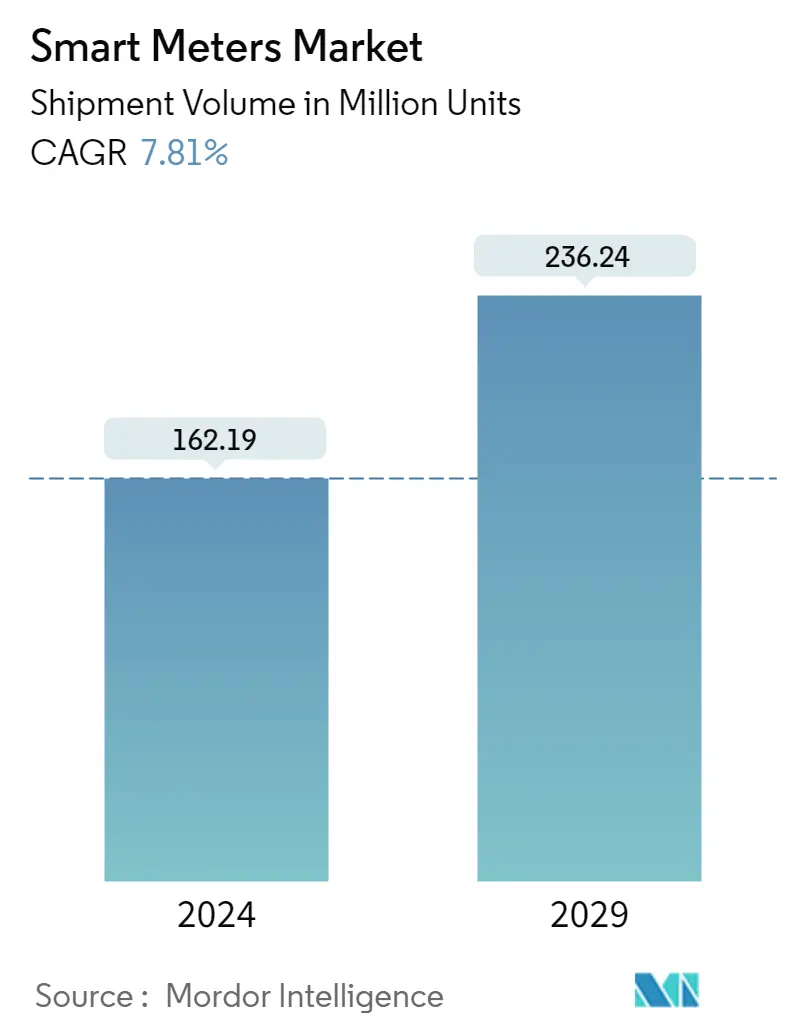
| Study Period | 2019 - 2029 |
| Base Year For Estimation | 2023 |
| CAGR (2024 - 2029) | 7.81 % |
| Fastest Growing Market | Asia Pacific |
| Largest Market | Asia Pacific |
| Market Concentration | Low |
Major Players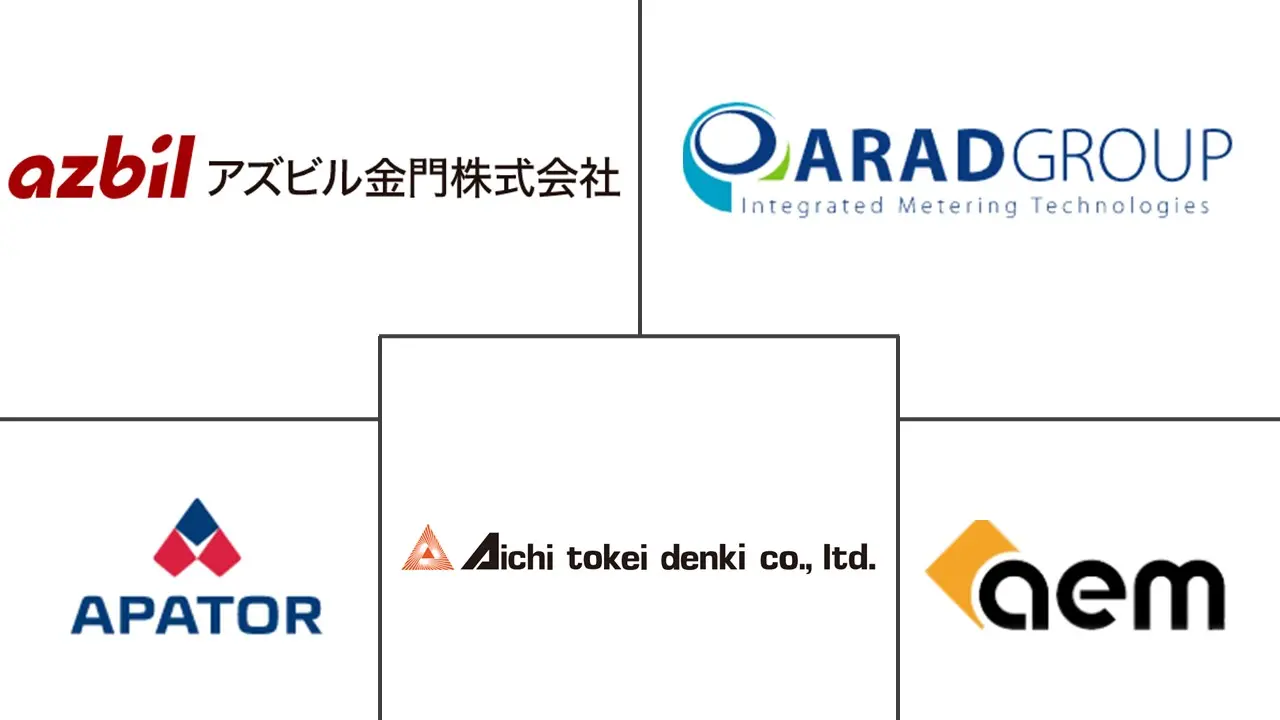
*Disclaimer: Major Players sorted in no particular order |
Smart Meters Market Analysis
The Smart Meters Market size in terms of shipment volume is expected to grow from 162.19 Million units in 2024 to 236.24 Million units by 2029, at a CAGR of 7.81% during the forecast period (2024-2029).
In order to increase the effectiveness of electrical networks, smart grids are being introduced all over the world. As a result, smart grids, which include smart electricity meters, are being deployed globally. To combat the negative impacts of pollution on the environment, nations all over the world are enacting emission control rules. This is the main factor driving the market.
- Due to their two-way communication capability, smart meters are being adopted more widely across the globe for various deployments, including electricity, gas, and water. This feature allows both utility suppliers and consumers to track utility usage in real-time and encourages suppliers to start, read, or cut off supply remotely.
- Consumer electronics, office equipment, and other plug loads consume nearly 15% to 20% of the total residential and commercial electricity while not in the primary mode. Most of this energy is consumed when they operate in low-power modes (even while they are not in use). Consumers are increasingly tending to install a smart energy management system to track such scenarios.
- Smart meters deployment also enables the implementation of a Home Energy Management System (HEMS) or Building Energy Management System (BEMS) that allows visualization of the electric power usage in individual homes or entire buildings.
- Further, digitization is accelerating and modernizing energy efficiency measures, due to which the deployment of smart grids is increasing globally, as they are capable of dynamically optimizing supply and fostering supply of large amounts of electricity from renewable energy sources such as solar power.
- Moreover, increasing government support and investments are expected to boost smart meters adoption and deployment in the country. For instance, India's state-owned Energy Efficiency Services Limited (EESL) completed the installation of approximately 10 lakh smart meters across India under the Government of India's Smart Meter National Programme. EESL set the target to install 25 crore smart meters over the next few years. Also, the need to establish a manufacturing base of smart electricity meters in the country to ensure an adequate supply of an adequate number of meters to be installed all over the country, by ruling out monopoly, is expected to act as a major driver.
- Lockdowns caused by the global COVID-19 epidemic caused a number of operations in many industries to come to a standstill. As a result, there was a decline in smart meter shipments and installations.
- However, as the COVID-19 requirements are gradually relaxed, it is anticipated that over time, the installation of smart meters will rise as well. The majority of energy providers are easily encouraging their consumers to update to smart meters in many developed locations.
Smart Meters Market Trends
Smart Electricity Meter Dominates the Market and will Continue its Dominance Over the Forecast Period
- Greater government support and investments are anticipated to accelerate the adoption and deployment of smart meters in Asia and the Pacific. In order to prevent monopolies and ensure an adequate supply of smart electricity meters that can be installed throughout the region, it is also necessary to establish a manufacturing base in the area. The state governments were urged to implement smart meters in three years and received an allocation of about INR 2,20,000 million (USD 2.677 billion) for the power and renewable energy sectors.
- According to the GSMA, by 2025, around 1.4 billion smart buildings and 700 million smart homes are expected to be in North America, mainly the United States and Canada, so an increasing number of smart buildings and homes are expected to also lead to an increase in the sale of smart electricity meters.
- Moreover, increasing urbanization and the increasing inclination toward a focus on developing urban lifestyles led to the expansion of the deployment of smart home technologies and devices, which involve automatic control of electricity, light, and energy to avoid wastage. Hence, the increasing adoption of smart home devices and technologies across homes globally is further expected to foster the growth of smart meters in the residential segment.
- Consumer electronics, office equipment, and other plug loads consume nearly 15% to 20% of the total residential and commercial electricity while not in the primary mode. Most of this energy is consumed when they operate in low-power modes (even while they are not in use). Consumers are increasingly inclined to install a smart energy management system to track such scenarios.
- According to the Energy Information Administration (EIA), global electricity generation capacity is expected to more than double in the next three decades, reaching approximately 14.7 terawatts by 2050. In 2020, the world's installed electricity capacity stood at 7.1 terawatts, which shows the demand for electricity around the globe is growing continuously. There is a growing need for utilities to manage and optimize their energy distribution networks. Thus, the availability of detailed information about energy consumption, which can help the consumer identify opportunities to reduce energy usage and save money with smart electricity meters, is projected to increase the adoption of smart electricity meters globally.
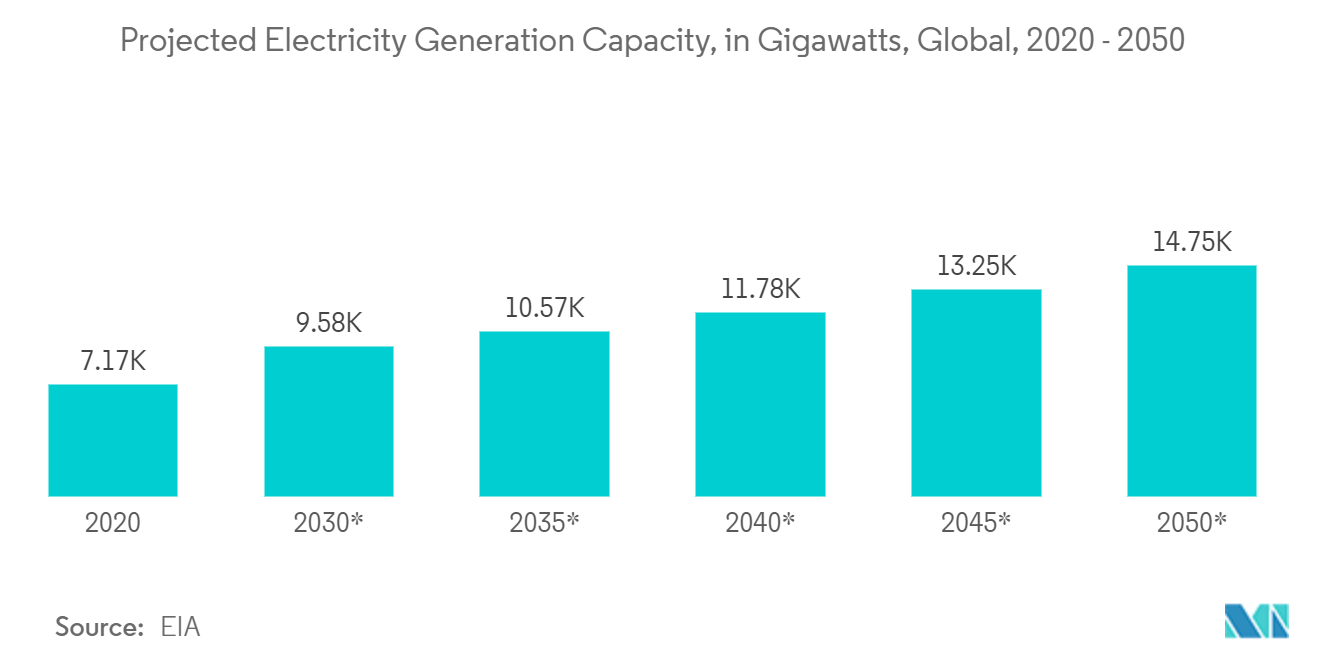
Asia-Pacific to Hold Major Share
- China is currently the leading segment in Asia Pacific, with the rollout at its peak due to strict mandates by the government of South China and State Grid, the only two grid companies in the country that drive the process. However, China is currently approaching full deployment, and the gradual end of the launch results in a significant reduction in annual demand.
- China is a major manufacturer of smart electricity meters, with a strong presence of local companies. It is also one of the largest producers of smart electric meters, which were consumed for domestic purposes during the rollout phase. State-owned enterprises dominate the Chinese market. Thus, it is nearly impossible for non-Chinese companies to compete in the country.
- Japan is the fifth-largest carbon emitter in the world. In 2021, the Japanese government promised to reduce emissions by 46% by 2030 due to pressure from many environmental organizations and European nations. Smart grid implementation, enhanced power and distribution networks, and low-carbon energy sources will likely help achieve this objective.
- By then, investor interest in smart grid technology was seen to have significantly increased in Japan due to the country's strong backing from the government, deregulation, and generally declining costs, with several large-scale projects. According to an Asian Power article, it is anticipated that up to 80 million smart meters will be installed nationwide by 2024.
- These improvements have mainly resulted from deploying smart electricity meters, DES, and energy storage technologies but have also seen numerous pilot projects and developments into other innovations like virtual power plants (VPPs), blockchain, and vehicle-to-grid (V2G) technologies. Additionally, the Japanese government plans to spend JPY 20 trillion (USD 155 billion) on promoting investments in new power grid technology, energy-saving homes, and other technology to reduce the nation's carbon footprint.
- The rest of the Asia-Pacific region contains countries and continents like New Zealand, India, Australia, the Philippines, Indonesia, Thailand, South Korea, Malaysia, Singapore, Vietnam, Bangladesh, Pakistan, and many more. Several government initiatives, partnerships, innovations, and acquisitions are expected to fuel market growth in the region during the projected period.
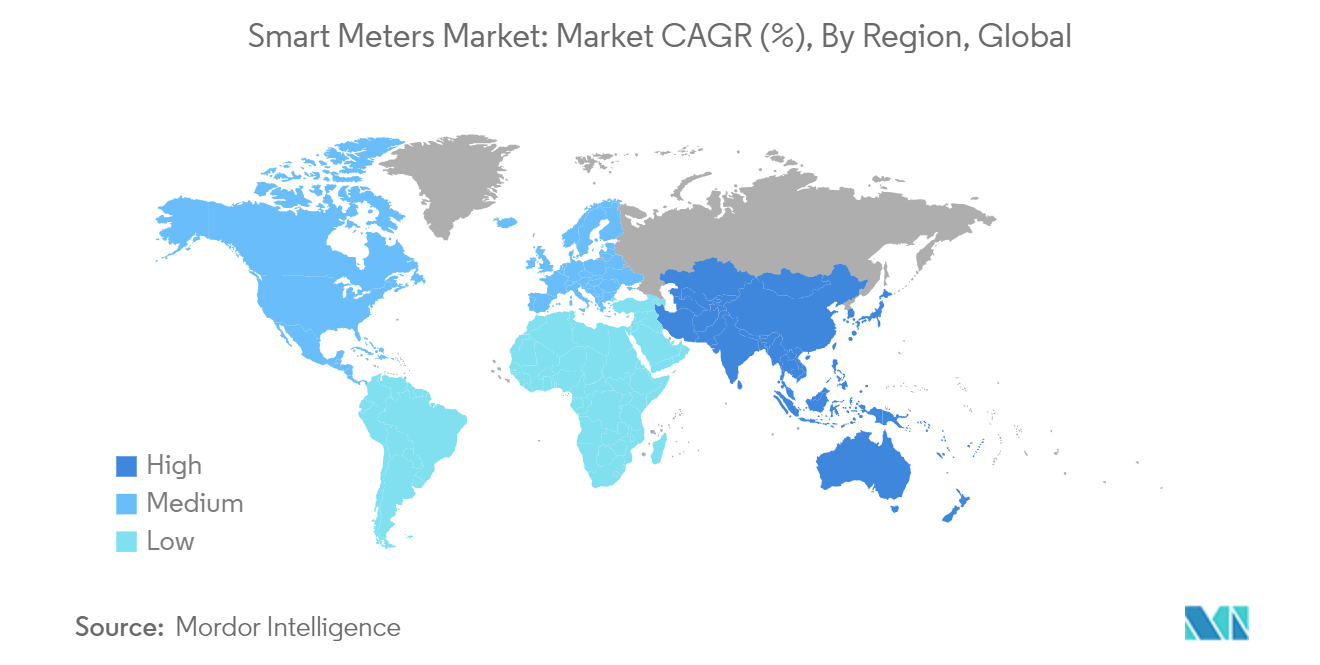
Smart Meters Industry Overview
The smart meter market is highly competitive and consists of several major players such as AEM, Aichi Tokei Denki Co., Ltd., Apator SA, Arad Group, and Azbil Kimmon Co., Ltd. The involvement of large-scale investments is increasing the barriers for the existing players, thereby pushing the industry toward competition. Also, smart meters are increasingly being deployed by various end users. Hence, the substantial increase in demand and government initiatives to increase the number of rollouts in various regions are expected to increase the degree of competition among the market players.
In January 2023, Badger Meter Inc. announced the strategic acquisition of Syrinix Ltd., a provider of intelligent water monitoring solutions. Through this acquisition, the company aims to add the hardware-enabled software capabilities of Syrinix to our smart water solutions portfolio. Similarly, it has also acquired Analytical Technology, Inc. (Ati) and Scan GmbH, leaders in intelligent measurement and smart water quality monitoring.
In January 2023, Diehl Stiftung & Co. KG announced that the Water and Sanitation Corporation (WASAC) in Rwanda's capital, Kigali, chose Diehl Metering for meter technology to modernize its network for its sustainability efforts. WASAC recognized the suitability of AURIGA to achieve its primary objective of reducing non-revenue water by installing reliable meters. The AURIGA water meter will form the basis for a future AMR solution.
In December 2022, Apator SA presented the smartESOX pro, which was specially designed for industrial applications, and the OTUS 3, a bidirectional smart electricity meter. Other smart options were presented, such as the Ultrimis W ultrasonic water meter and the iSMART2 gas meter.
Smart Meters Market Leaders
-
AEM
-
Aichi Tokei Denki Co., Ltd.
-
Apator SA
-
Arad Group
-
Azbil Kimmon Co. Ltd
*Disclaimer: Major Players sorted in no particular order
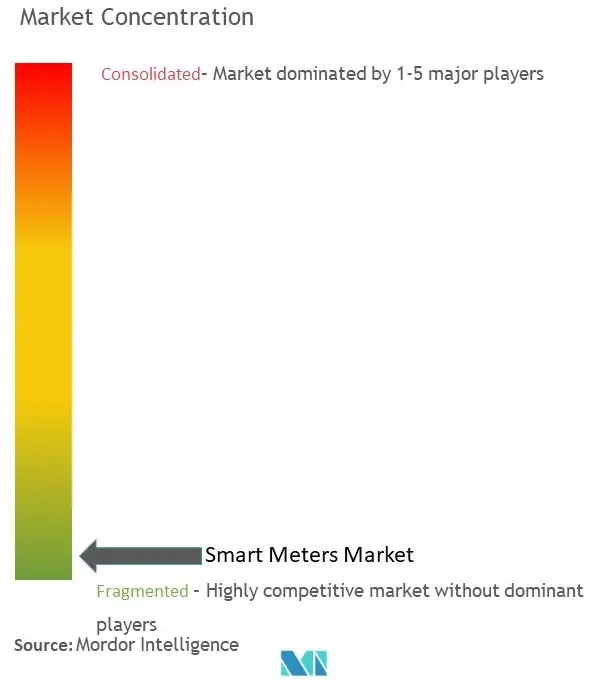
Smart Meters Market News
- March 2023: Diehl Metering Inc. announced a strategic partnership with STACKFORCE GmbH, a German company specializing in embedded software for communicating IoT devices and related integration devices. Through this partnership, Diehl aims to maintain its leading position in the market and further expand in the communication technology market for smart meters, smart utilities, and smart cities.
- March 2023: Itron Inc. announced that Peoples Gas and North Shore Gas, subsidiaries of WEC Energy Group, are operating together with ComEd, an energy provider to over 4 million customers, to share ComEd's existing Itron advanced metering infrastructure (AMI) multi-purpose network to assist smart technology that will streamline natural gas meter reading to build efficiencies and lower carbon emissions.
- March 2023: Landis+GyrTechnology Inc. and WEC Energy Group announced a partnership to expand the Advanced Metering Infrastructure (AMI) coverage for gas and electric meters and develop the current managed services agreement through 2038. It includes 210,000 G480 ultrasonic gas meters, 750,000 AMI gas modules, and 204,000 advanced electric meters.
Smart Meters Market Report - Table of Contents
1. INTRODUCTION
- 1.1 Study Assumptions and Market Definition
- 1.2 Scope of the Study
2. RESEARCH METHODOLOGY
3. EXECUTIVE SUMMARY
4. MARKET INSIGHTS
- 4.1 Market Overview
-
4.2 Industry Attractiveness - Porter's Five Forces Analysis
- 4.2.1 Bargaining Power of Suppliers
- 4.2.2 Bargaining Power of Buyers
- 4.2.3 Threat of New Entrants
- 4.2.4 Threat of Substitute Products
- 4.2.5 Degree of Competition
- 4.3 Industry Value Chain Analysis
- 4.4 Impact of COVID-19 on the Industry
5. MARKET DYNAMICS
-
5.1 Market Drivers
- 5.1.1 Increased Investments in Smart Grid Projects
- 5.1.2 Need for Improvement in Utility Efficiency
- 5.1.3 Supportive Government Regulations
- 5.1.4 Growth in Smart City Deployment
- 5.1.5 Demand for Sustainable Utility Supply for All End Users
-
5.2 Market Challenges
- 5.2.1 High Costs and Security Concerns
- 5.2.2 Integration Difficulties with Smart Meters
- 5.2.3 Lack of Capital Investment for Infrastructure Installation and Lack of ROI
- 5.2.4 Utility Supplier Switching Costs
6. MARKET SEGMENTATION
-
6.1 By Geography - Smart Gas Meter
- 6.1.1 North America
- 6.1.1.1 United States
- 6.1.1.2 Canada and Central America
- 6.1.2 Europe
- 6.1.2.1 United Kingdom
- 6.1.2.2 France
- 6.1.2.3 Italy
- 6.1.2.4 Rest of Europe
- 6.1.3 Asia Pacific
- 6.1.3.1 China
- 6.1.3.2 Japan
- 6.1.3.3 Rest of Asia Pacific
- 6.1.4 Rest of the World
-
6.2 By Geography - Smart Water Meter
- 6.2.1 North America
- 6.2.1.1 United States
- 6.2.1.2 Canada and Central America
- 6.2.2 Europe
- 6.2.2.1 United Kingdom
- 6.2.2.2 France
- 6.2.2.3 Italy
- 6.2.2.4 Rest of Europe
- 6.2.3 Asia-Pacific
- 6.2.3.1 China
- 6.2.3.2 Japan
- 6.2.3.3 Rest of Asia-Pacific
- 6.2.4 Rest of the World
-
6.3 By Geography - Smart Electricity Meter
- 6.3.1 North America
- 6.3.1.1 United States
- 6.3.1.2 Canada and Central America
- 6.3.2 Europe
- 6.3.2.1 United Kingdom
- 6.3.2.2 France
- 6.3.2.3 Italy
- 6.3.2.4 Rest of Europe
- 6.3.3 Asia Pacific
- 6.3.3.1 China
- 6.3.3.2 Japan
- 6.3.3.3 Rest of Asia Pacific
- 6.3.4 Rest of the World
7. COMPETITIVE LANDSCAPE
-
7.1 Company Profiles
- 7.1.1 AEM
- 7.1.2 Aichi Tokei Denki Co.Ltd.
- 7.1.3 Apator SA
- 7.1.4 Arad Group
- 7.1.5 Azbil Kimmon Co. Ltd.
- 7.1.6 Badger Meter Inc.
- 7.1.7 Diehl Stiftung & Co. KG
- 7.1.8 Elster Group GmbH (Honeywell International Inc.)
- 7.1.9 General Electric Company
- 7.1.10 Hexing Electric company Ltd.
- 7.1.11 Holley Technology Ltd.
- 7.1.12 Itron Inc.
- 7.1.13 Jiangsu Linyang Energy Co. Ltd.
- 7.1.14 Kamstrup A/S
- 7.1.15 Landis+ GYR Group AG
- 7.1.16 Mueller Systems LLC (Muller Water Products Inc.)
- 7.1.17 EDMI Limited (OSAKI ELECTRIC CO. LTD.)
- 7.1.18 Neptune Technology Group Inc. (Roper Technologies, Inc.)
- 7.1.19 Ningbo Sanxing Medical Electric Co., Ltd
- 7.1.20 Pietro Fiorentini SpA
- 7.1.21 Sagemcom SAS
- 7.1.22 Sensus USA Inc. (Xylem Inc.)
- 7.1.23 Aclara Technologies LLC (Hubbell Inc.)
- 7.1.24 Wasion Holdings Limited
- 7.1.25 Yazaki Corporation
- 7.1.26 Zenner International GmbH & Co. KG
- *List Not Exhaustive
8. MARKET OPPORTUNITIES AND FUTURE TRENDS
- 8.1 Future of the Market - Smart Electricity Meter
- 8.2 Future of the Market - Smart Gas Meter
- 8.3 Future of the Market - Smart Water Meter
Smart Meters Industry Segmentation
Smart meters are digital meters that represent a transformative technology for the utility industry and its customers. It enables either one-way or two-way communication between the meter and the supplier. These technologically advanced meters display real-time energy usage, provide greater insight into energy usage, and use a secure smart data network to automatically and wirelessly send the readings to the energy supplier to generate accurate bills.
The scope of the study includes the shipment of various kinds of smart meters, including smart gas, smart water, and smart electricity meters. The market size is calculated based on the unit shipments of the meters. In addition, the study analyzes the impact of COVID-19 on the market.
The smart meters market is segmented by smart gas meters (North America (United States, Canada & Central America), Europe (United Kingdom, France, Italy, and the Rest of Europe), Asia Pacific (China, Japan, and the Rest of Asia Pacific), Rest of the World), by smart water meters (North America (United States, Canada & Central America), Europe (United Kingdom, France, Italy, and the Rest of Europe), Asia Pacific (China, Japan, and the Rest of Asia Pacific), Rest of the World), by smart electricity meters (North America (United States, Canada & Central America), Europe (United Kingdom, France, Italy, and the Rest of Europe), Asia Pacific (China, Japan, and the Rest of Asia Pacific), Rest of the World). The market sizes and forecasts are provided in terms of value in USD for all the segments.
| By Geography - Smart Gas Meter | North America | United States |
| Canada and Central America | ||
| By Geography - Smart Gas Meter | Europe | United Kingdom |
| France | ||
| Italy | ||
| Rest of Europe | ||
| By Geography - Smart Gas Meter | Asia Pacific | China |
| Japan | ||
| Rest of Asia Pacific | ||
| By Geography - Smart Gas Meter | Rest of the World | |
| By Geography - Smart Water Meter | North America | United States |
| Canada and Central America | ||
| By Geography - Smart Water Meter | Europe | United Kingdom |
| France | ||
| Italy | ||
| Rest of Europe | ||
| By Geography - Smart Water Meter | Asia-Pacific | China |
| Japan | ||
| Rest of Asia-Pacific | ||
| By Geography - Smart Water Meter | Rest of the World | |
| By Geography - Smart Electricity Meter | North America | United States |
| Canada and Central America | ||
| By Geography - Smart Electricity Meter | Europe | United Kingdom |
| France | ||
| Italy | ||
| Rest of Europe | ||
| By Geography - Smart Electricity Meter | Asia Pacific | China |
| Japan | ||
| Rest of Asia Pacific | ||
| By Geography - Smart Electricity Meter | Rest of the World |
Smart Meters Market Research FAQs
How big is the Smart Meters Market?
The Smart Meters Market size is expected to reach 162.19 million units in 2024 and grow at a CAGR of 7.81% to reach 236.24 million units by 2029.
What is the current Smart Meters Market size?
In 2024, the Smart Meters Market size is expected to reach 162.19 million units.
Who are the key players in Smart Meters Market?
AEM, Aichi Tokei Denki Co., Ltd., Apator SA, Arad Group and Azbil Kimmon Co. Ltd are the major companies operating in the Smart Meters Market.
Which is the fastest growing region in Smart Meters Market?
Asia Pacific is estimated to grow at the highest CAGR over the forecast period (2024-2029).
Which region has the biggest share in Smart Meters Market?
In 2024, the Asia Pacific accounts for the largest market share in Smart Meters Market.
What years does this Smart Meters Market cover, and what was the market size in 2023?
In 2023, the Smart Meters Market size was estimated at 150.44 million units. The report covers the Smart Meters Market historical market size for years: 2019, 2020, 2021, 2022 and 2023. The report also forecasts the Smart Meters Market size for years: 2024, 2025, 2026, 2027, 2028 and 2029.
What is the future outlook for the Smart Meters Market?
The Smart Meter Market is expected to grow significantly, driven by ongoing energy efficiency initiatives, technological advancements, and the global push towards sustainable energy solutions.
What are the latest technological advancements in Smart Meters?
Key technological advancements in the Smart Meters Market are: a) Enhanced communication capabilities b) Improved data analytics c) Integration with home energy management systems
Smart Meter Industry Report
The Global Smart Meter Market is on a significant upswing, fueled by the demand for energy efficiency and grid modernization. This growth is catalyzed by the increasing population and urbanization, leading to a spike in energy consumption. Smart meters, encompassing smart electric, gas, and water meters, are pivotal in this shift, providing real-time energy usage data, thus enabling better consumption and operational efficiency decisions. The market benefits from trends like mobile device management and Internet of Things (IoT) integration, enhancing supply chain accuracy and minimizing manual errors. The Asia-Pacific region leads with extensive rollouts and government initiatives for sustainable energy. Despite the hurdles of high capital costs and the need for consumer education, the advent of Artificial Intelligence (AI) and Machine Learning (ML) technologies opens new avenues. The competitive arena features top smart meter companies innovating and expanding their offerings to cater to the increasing demand, positioning smart meters as key to global sustainable energy management efforts. For detailed insights, Mordor Intelligence™ offers a comprehensive analysis, including market share, size, revenue growth, and forecasts, available as a free report PDF download.



